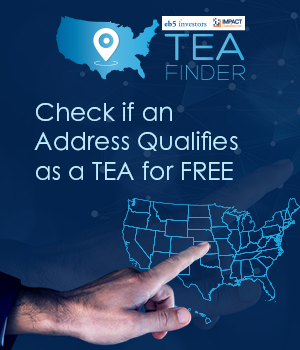Updated by Michael Kester on May 11, 2020
Getting an EB-5 project a targeted employment area (TEA) designation can be incredibly important for EB-5 investors. The required EB-5 investment amount is lowered from $1.8 million to $900,000 dollars if the EB-5 project is conducted in a TEA. In order to be designated as a TEA, the EB-5 project must be located in either a rural area or in a location that has high unemployment. Targeted employment area designation is requested within the EB-5 investor’s I-526 petition. If you invest in a regional center, the regional center should provide you with the evidence/documentation that the project is located in a TEA.
There have been significant recent changes to how project locations may qualify as TEAs. The EB-5 Immigrant Investor Program Modernization regulation was published by Department of Homeland Security (DHS) in the Federal Register on July 24, 2019 went into effect on November 21, 2019. The main program changes related to TEAs are as follows:
- Census tract combination for high-unemployment TEAs is now much more restrictive: census tract aggregation is limited to the project tract(s) plus some or all of the tracts that are “directly adjacent” to the project tract. In other words, a TEA that needs to rely on census tract combination can only aggregate tracts that touch the project tract. Utilizing census block groups (a census tract is made up of several block groups) is no longer allowed (only census tracts), which also restricts the flexibility that was previously afforded under the prior rules.
- DHS has removed the ability of the individual states to designate high-unemployment areas. Instead, DHS will make such determinations at the I-526 stage. Instead of providing a state-issued letter as was previously done, investor petitions will need to contain sufficient evidence (such as a TEA opinion letter) demonstrating that the project location meets the new standards for the reduced investment threshold ($900,000).
What is a TEA rural area?
There is a specific set of criteria that an EB-5 project location must meet to qualify as a TEA rural area. Rural areas must not be within a metropolitan statistical area as labeled by the U.S. Office of Management and Budget. A rural area must also be outside of a town or city that has a population of 20,000 residents based on the most recent decennial U.S. Census (currently 2010). If the project location is a rural area at the time of the EB-5 investment, then it may be designated as a TEA. The new regulations did not alter the Rural TEA criteria.
What is a high unemployment TEA?
If the project does not qualify as rural, an EB-5 project location must then experience an unemployment rate of at least 150 percent of the U.S. national average to receive TEA designation due to high unemployment. While most high unemployment TEA designations must rely on a census tract analysis, a high unemployment area may also be a county or metropolitan statistical area (MSA) that meets the 150% national average rate requirement on its own. Cities can only qualify individually if they are both outside an MSA and have a population greater than 20,000. As previously discussed, census tract combination, when needed, is now limited only to census tracts that are “directly adjacent” to the census tract(s) of the project. This is a significant limitation compared to the previous rules, in which the States had flexibility to certify tract aggregations of any kind as long as they were contiguous and met the required 150% threshold. USCIS does not have a specific limit on the number of tracts that can be combined, but combination is limited to the project tract(s) and any or all “directly adjacent” tracts. An EB-5 project can qualify as a high unemployment TEA if the principal location of the project is located in a high unemployment area at the time the EB-5 investment is made or at the time the I-526 is filed (whichever comes first).
What Evidence is Needed for TEA Qualification?
Targeted employment area designation is adjudicated as part of the I-526 application. The EB-5 visa applicant must provide sufficient evidence that their project is located within a rural or high unemployment area. Under the new rules, States are no longer permitted to certify high unemployment TEAs, and so each I-526 must include evidence documenting that the area where the petitioner has invested or is actively in the process of investing is a high unemployment area at the applicable time of determination. According to USCIS, this evidence for high unemployment TEAs should be reliable and verifiable and could consist of the following:
- Location where the project is principally doing business
- Map that clearly demonstrates the census tract or tracts that are included in the proposed TEA (limited to directly adjacent tracts only, if proposing multiple tracts)
- Detail behind the calculations of the weighted average of the unemployment rate for the proposed TEA
- The source of the unemployment statistics for the proposed TEA (data and methods must be “reliable and verifiable”)
DHS did not mandate that one set of data or one methodology must be used for a high unemployment TEA. The main requirement is that the data be “reliable and verifiable.” DHS stated that labor force data published by the American Community Survey (ACS) and the Bureau of Labor Statistics (BLS) qualify as reliable and verifiable data sources, so these two datasets can be used to provide evidence that a site qualifies as a TEA.
For a Rural TEA, the I-526 petition should include evidence that the project location is both outside of an MSA (according to the Office of Management and Budget) and also outside of a city or town with a population of 20,000 or more (per the most recent decennial census).
If the EB-5 investment meets the $1.8 million threshold, there is no need to provide evidence of TEA qualification.
The TEA requirements are the same for Regional Center projects and Direct EB-5 projects.







